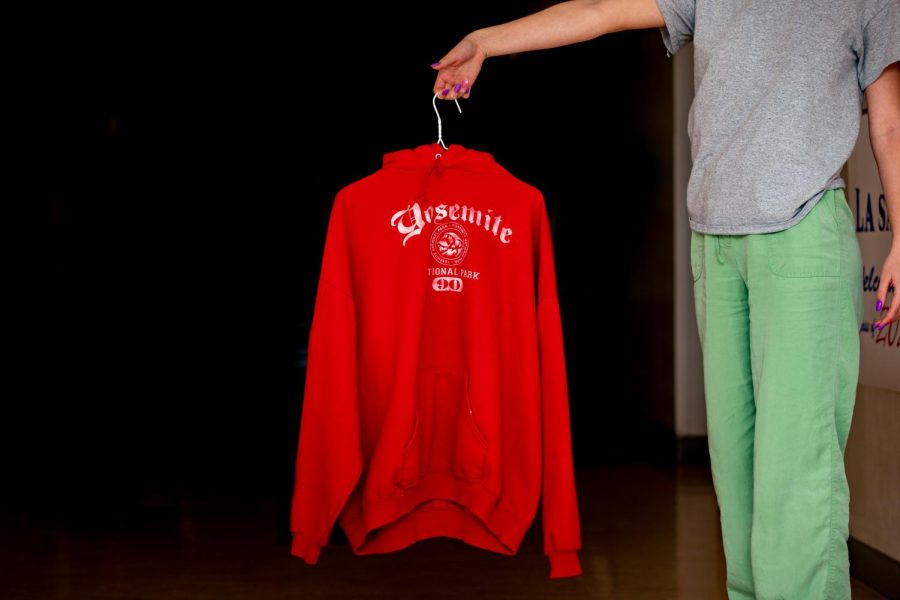Thrifting: A Fashionable Solution to a Multitude of Issues
Many students at La Salle thrift as a way to express their own fashion choices.
February 12, 2020
Finding the perfect T-shirt in the winding racks of your local thrift store can sometimes be a day-long process, which for some people is far too long to be out shopping. Despite this, thrift shopping has taken over many wardrobes of the students here at La Salle due to the numerous benefits that second-hand shopping provides.
Thrifting is a sustainable way to better the environment, an ethical substitute for fast fashion, and an outlet to discover your style. Here is our take on four of the benefits of second-hand shopping:
1) Bettering The Environment
According to the University of California Berkeley’s Student Environmental Resource Center, Americans throw away about 10.5 million tons of clothing every year, and synthetic materials like polyester, nylon, and acrylic make up 60 percent of the clothes made worldwide. Thrifting promotes the reuse of these pieces, keeping more of these materials out of landfills for a longer period of time.
In addition to reducing the amount of waste we create from manufacturing clothing, thrifting also decreases the amount of energy we use to make these clothing items.
“Recycling or reusing cotton clothing uses just 2.6 percent of the energy required to manufacture a garment from virgin materials,” according to the GRACE Communications Foundation on their Water Footprint Calculator.
The majority of this energy comes from burning fossil fuels, which creates air pollution. According to the World Health Organization (WHO), nine out of ten people now breathe polluted air, which kills seven million people every year. Air pollution causes one-third of deaths from stroke, lung cancer, and heart disease.
Donating our clothes to thrift stores for someone else to use allows manufacturers to use less energy and reduces air pollution.
2) Reduces Clothing Costs For Shoppers
With thrift stores reselling clothing at much less than the original retail value, Lasallians (and people worldwide) can save a considerable amount of money from choosing to thrift as opposed to buying new. “The average American consumer spends $1,000 to $2,000 each year on clothing,” according to the U.S. Bureau of Labor Statistics.
As for where people can go to find these items at such low prices, La Salle students recommend a variety of places near our school. Sophomores Shayden Lough and Ava Whalon suggest a store called Red Light Clothing Exchange, where Lough got her favorite leather jacket.
“My go-to thrift store is the Goodwill Outlet, and since the selection is very random I have found everything from graphic tees to prom dresses,” sophomore Natalie Fuchs said. “I’m not going to complain about spending a fraction of the original price!”
Senior Mollie Kuffner recommends thrifting hubs such as Deseret Industries, Goodwill, Better Bargain, and Red White and Blue.
“For me, I don’t think shirts are worth like fourteen dollars at a regular store,” she said. “That’s so expensive. There are more important things that your money can go to than just buying brand new clothes. So what if it’s a little worn, right?”
3) Reduces Child Labor
In addition to preserving the environment without breaking the bank, thrifting is a friendlier option in terms of origin.
Mass production of chain clothing store garments typically occurs in a factory-like setting known as a sweatshop. Large retail companies often rely on sweatshops based out of poorer countries because they can easily get away with severely underpaying their workers. “Poverty leads these children to accept the job, or their parents ask them to work to supplement the family income,” said the organization End Slavery Now.
According to The United Nations, over 73 million children are forced into dangerous conditions of child labor. “As retailers across the country face increasingly tough competition from e-commerce, budget brands like Forever 21 are putting more and more pressure on suppliers to keep prices low,” said The Los Angeles Times.
Thrifting offers an alternative instead of buying into consumerism. By choosing to thrift rather than purchasing items from fashion industries that partake in the mistreatment of youth around the world, we choose social justice over material consumerism.
4) Helps You Find Your Style
“Thrifting is really a good way to help find your fashion taste because you’re not really guided by a specific store,” Lough said. “When it comes to fashion, people should wear what makes them feel like themselves. In my eyes, what you wear is how you show off your personality.”
You don’t need to sacrifice your own personal style when purchasing second-hand items. Often students express themselves and their personalities through the clothes they wear, and thrifting can help with finding your own sense of style.
“I thrift because there’s a lot of life left in clothing people don’t want anymore and I love getting a good deal,” Fuchs said. “I also really enjoy making alterations to pieces I think are really cute and have potential. The skirts I find are generally too large so I’ve gotten used to sewing them, but I’d say 65% of my closet is thrifted.”
Overall, despite thrifting being perhaps different than the norm, it’s a wonderful way to find new clothing while making the world a better place.







Meg Zins • Sep 19, 2024 at 9:41 am
Love this piece. Creative, practical, and wise.
Lisa Daniels • Feb 13, 2020 at 11:36 am
Thanks for sharing these eye-opening statistics. This is good for all of us to know.